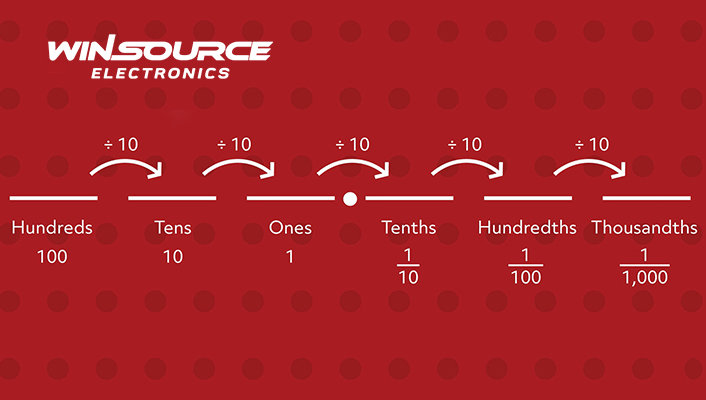
How to convert a decimal to a fraction: an essential skill for every electronics enthusiasts
In the thrilling realm of electronics, precision is everything. Being able to seamlessly switch between decimals and fractions can be a game-changer, especially when dealing with the intricacies of electronic components. As passionate enthusiasts at WIN SOURCE, we believe in empowering our community with the right tools and knowledge. How to convert a decimal to a fraction and vice versa. At WIN SOURCE, we know the importance of precision, so let’s get started!
Table of Contents
ToggleDecimals and fractions: What’s the big deal?
Before we go to the conversion process, let’s break down the basics. Decimals are numbers expressed in the base-10 system, which includes a point to separate the whole number from the fractional part. A fraction, meanwhile, is a number represented as one integer divided by another. While they might look different, both can express the same value. For instance:
• Decimal: 0.5
• Fraction: ½
Both represent the same value, but in different formats. The question then is, how to convert a decimal to a fraction or the reverse? And how can we shuttle between the two? Let’s find out.
From dots to bars: Changing decimals into fractions
The process is simpler than it sounds! Follow these steps:
1) Write your decimal as the numerator (without the dot).
2) Determine the place value of the decimal (Is it in tenths? Hundredths?) and make this your denominator.
3) Simplify the fraction if possible.
For example, 0.25 becomes 25/100, which can be simplified to ¼. There you go – you’ve mastered how to turn a decimal into a fraction.
Reversing the roles: Transforming fractions to decimals
Got a fraction you’d like to see as a decimal? Sometimes, you might need to flip the process, especially when working with electronic components where decimals might be more appropriate. The route is direct:
1) Perform a straightforward division: numerator divided by denominator.
2) The quotient you get is the decimal.
Let’s take ¾. Dividing 3 by 4 provides 0.75. Simple, isn’t it?
Why do electronics buffs care about this?
The world of electronics thrives on precision. When tinkering with circuits or deciding on components, having the ability to interpret values, whether they’re in fractions or decimals, can save time and reduce errors. At times, manufacturers may choose to list values in either format. By understanding how to change a decimal to a fraction and vice versa, you’re ensuring smooth sailing through your projects. It’s this blend of knowledge and the quality components from WIN SOURCE that can set you up for success.
Practical applications in the electronics domain
Picture this: you’re deep into a project, and you come across a series of numbers. Some are fractions; others are decimals. As an avid electronics hobbyist or professional, you understand that every tiny nuance can make a world of difference. So why would knowledge on how to convert a decimal to a fraction come into play in the real world of electronics?
1. Circuit design
When you’re crafting the perfect circuit, component values can come in both forms. Maybe you’ve got a resistor value given as a decimal, but it makes more sense to view it as a fraction for precise tuning.
2. Component choice
You’re browsing through a catalog or the WIN SOURCE website, and you spot component ratings. Being able to switch between decimals and fractions ensures you always pick the right component for your project without second-guessing.
3. Power consumption
When calculating the power usage of a project, decimals might be more intuitive. But what if you need to present this info to a colleague or client? Sometimes, a fraction can provide a clearer picture.
4. Cross-border collaboration
Electronics is universal, but the way we approach numbers isn’t always. Working with teams from different parts of the world, being able to swiftly convert between decimals and fractions can smooth out communication.
5. Troubleshooting & Diagnostics
Whether you’re debugging a circuit or calibrating an instrument, accurate readings are crucial. Decimals are often easier to compare at a glance. Still, when you’re referencing manufacturer data sheets or following a tutorial, that information might be given in fractions. Understanding how to convert a decimal to a fraction or vice versa can help bridge that gap, ensuring you accurately identify and address issues.
It’s all about flexibility and adaptability. In a field as intricate and precise as electronics, even something seemingly small like knowing how to turn a fraction into a decimal can significantly enhance your workflow.
Electronics and WIN SOURCE: A partnership built on expertise
In the vast landscape of electronics, the little things matter. Understanding how to shuffle between decimals and fractions might seem minor, but it can profoundly impact your work’s accuracy and efficiency. Always keep this guide at hand and face numeric challenges head-on.
It’s not just about selling electronic components. At WIN SOURCE, we’re passionate about fostering a community of informed enthusiasts. When you’re backed by knowledge, like the nifty trick of converting decimals to fractions, you’re truly unstoppable in the world of electronics. Our mission is to both supply the components you need and equip you with the wisdom to use them best.
Visit our product store to explore a curated selection of top-quality electronic components, ensuring precision and performance for all your projects.

COMMENTS